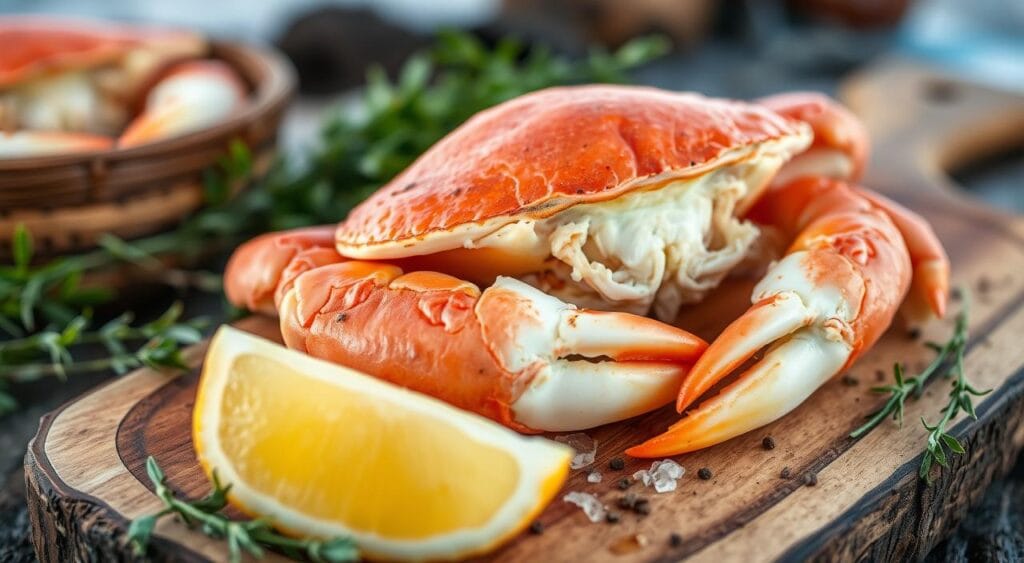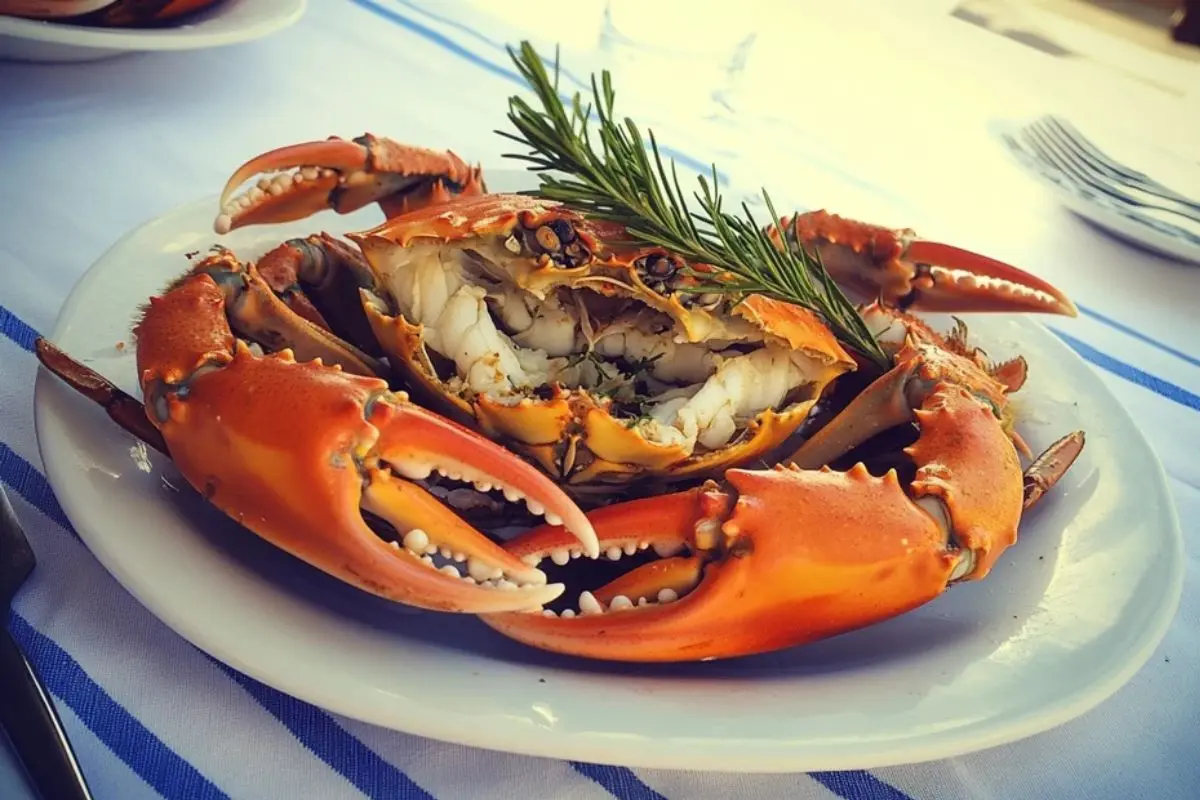Indulge in mouthwatering tasty crab dishes that’ll satisfy your seafood cravings. From succulent crab legs to savory crab cakes, this article will explore the best crab recipes to enjoy today. Get ready to dive into the world of delectable crab-based dishes and discover new ways to savor this beloved seafood delicacy.
Key Takeaways
- Explore a diverse range of flavorful crab dishes from different regions in the United States
- Discover various cooking techniques like baking, broiling, and incorporating crab in creamy sauces
- Indulge in unique ingredient combinations like wasabi, avocado, and herbs for added depth of flavor
- Enjoy versatile serving suggestions, from casual to special occasion crab dishes
- Explore a mix of seafood proteins, including crab, shrimp, scallops, and fish, in the recipes
Ingredients (or Main Points)
Crab is the star in the delicious recipes in this article. You can use lump crab meat, soft-shell crab, or fresh crabmeat to make amazing dishes.
Crab can be used in many ways, like in tasty crab cakes or creative crab-stuffed dishes. One pound of fresh crabmeat can make six big crab cakes or 12 small ones. This way, you get the most out of this special ingredient.
Crab Varieties and Uses
- Lump crab meat – Great for crab cakes, dips, and salads
- Soft-shell crab – Tastes amazing when fried or sautéed
- Fresh crabmeat – Works well in many crab-based recipes
Choosing any type of crab will make your dishes more flavorful and fun to eat.

“The secret to a truly mouthwatering crab dish is to let the natural sweetness and delicate texture of the crab shine through.”
Instructions/Process/Steps
To make tasty crab dishes, start by preparing the crab. This might mean cleaning, deveining, and cooking it. After that, mix it with veggies, spices, and seafood for extra flavor. The steps change with each recipe, but always highlight the crab’s natural taste and texture.
Step 1: Prepare the Crab
- If you have fresh crab, chill it in the freezer for 15 minutes. This makes it easier to handle.
- Boil the crab for about 15 minutes. Then, quickly cool it in an ice bath to stop cooking.
- Take off the top shell, the triangular part, the gills, and clean out the intestines.
- Break the legs and claws by hand or with a mallet if needed.
- Split the crab body in half by folding it back and forth.
Step 2: Combine Crab with Complementary Ingredients
After preparing the crab, mix it with other ingredients for tasty crab recipes. Here are some ideas:
- Harissa Butter: Mix 1/2 stick of butter, 1/2 tablespoon of harissa powder, 1 thinly sliced garlic clove, and lemon juice.
- Lemon-Garlic Butter: Combine 1/2 stick of butter, lemon juice, and 1 thinly sliced garlic clove.
For serving, use napkins, lemon wedges, and choose Harissa Butter or Lemon-Garlic Butter for dipping. Also, have crab crackers and leg forks ready for easier eating.
“The key to delicious crab dishes is to let the natural sweetness and texture of the crab shine through, while complementing it with just the right ingredients.”
Serving and Storage Tips (or Application/Usage Notes)
Enjoying crab dishes is a treat. There are a few key tips to remember. You can serve them warm or cold, making them perfect for any event.
Serve Crab Dishes Warm or Cold
Warm crab dishes, like crab cakes or crab-stuffed shells, are great as a main course or appetizer. They offer rich flavors that go well with many sides. Cold crab dishes, such as crab salad or crab cocktail, are ideal for summer or light meals.
Store Leftover Crab Properly
Storing leftover crab is important. Put it in an airtight container in the fridge. Eat it within 3-4 days for the best taste and safety.
“Crab dishes are truly versatile, allowing you to savor their flavors in a variety of ways. Whether you prefer them warm and comforting or chilled and refreshing, there’s a crab dish to suit every occasion.”
Follow these tips to enjoy your crab dishes, crab legs, and crab cakes to the fullest. They’ll stay fresh and delicious from start to finish.
Benefits/Advantages
Crab is not just a tasty crab treat but also packed with health benefits. It’s a lean protein, low in fat and calories. This makes it perfect for those watching their diet.
Crab is full of important nutrients like vitamin B12, selenium, and omega-3 fatty acids. These help keep you healthy and strong. Plus, crab meat has lots of protein but less saturated fat than other meats.
The omega-3s in crab can lower cholesterol and heart disease risk. It also has phosphorus for strong bones and copper for better iron absorption. This improves blood cells and circulation.
“Crab is not only a delicious seafood delicacy, but it also offers a wide range of health benefits that make it a nutritious choice for your diet.”
Crab is also rich in selenium, a key mineral for antioxidants and immune support. Adding crab to your diet can boost your overall health.
But, eating too much crab can be bad due to copper and zinc. It’s important to eat it in moderation. Still, crab’s nutritional value and tasty crab taste make it a great choice for a healthy diet.
Looking to add more seafood delicacies or try new crab recipes? Crab is a great pick for its health benefits and delicious taste.
Variations/Alternatives
Crab dishes offer endless possibilities. Crab is the main ingredient in these recipes, but there’s more to discover. You can mix crab with shrimp, scallops, or lobster for unique dishes.
Crab cakes are just the beginning. Try different binders like breadcrumbs or panko. Add spices and herbs for your own flavor. For a casual option, boil or steam crab legs with melted butter or a tasty sauce.
Let the crab’s natural sweetness and soft texture be the focus. With so many options, you’ll find a new favorite dish.
Crab Dish Variations to Explore
- Crab and Shrimp Linguine
- Crab and Scallop Stuffed Portobello Mushrooms
- Crab and Lobster Mac and Cheese
- Panko-Crusted Crab Cakes with a Lemon-Dill Sauce
- Steamed Crab Legs with Garlic Butter Dipping Sauce
“Crab is one of the most versatile and delicious ingredients to work with in the kitchen. The possibilities are truly endless when it comes to creating unique and mouthwatering crab dishes.”
Looking for a classic crab cake or something new? The crab recipe world is vast. So, don’t hesitate to try new things.
Common Mistakes to Avoid
Preparing crab recipes and dishes can be a joy. But, it’s key to avoid common mistakes that can ruin the taste and texture. Overcooking crab or mixing crab cakes too much can make a big difference.
One big thing to watch is cooking time. If crab is overcooked, it becomes tough and dry. If it’s undercooked, it’s not safe to eat. So, it’s important to cook it just right.
Another mistake is overmixing crab cakes. This makes them dense and rubbery. It’s better to mix the ingredients gently, being careful with the crab meat.
Also, don’t overdo it with binders like breadcrumbs or mayonnaise. They help hold the cakes together, but too much can hide the crab’s natural taste.
By avoiding these mistakes, you can make the most of crab recipes. This way, you can enjoy the delicate and delicious flavors of this seafood treasure.
Helpful Notes (or Extra Considerations)
Exploring tasty crab dishes is exciting. Rebecca Bent, a Baltimore native, is a renowned cookbook author. She loves sharing Maryland’s Eastern Shore culinary traditions.
Expert Advice from Rebecca Bent
Rebecca Bent says the key to great crab flavor is using Maryland blue crabs. “These crabs have sweet, delicate meat that makes every dish special,” she notes. “When cooking with crab, handle it gently and let its natural flavors shine.”
Insights from The Crab Place
The Crab Place is a top source for Maryland blue crabs. They offer tips on choosing, preparing, and enjoying crab. “Crab is great in many tasty crab dishes, from crab cakes to crab brulee,” they say. “Whether you’re a crab lover or new to crab recipes, there’s always more to learn.”
FAQ
What are the key ingredients used in tasty crab dishes?
The main ingredient in tasty crab dishes is fresh crabmeat. It can be lump crabmeat, soft-shell crab, or other types of fresh crab.
How do I properly prepare crab for cooking?
To prepare crab, you might need to clean, devein, and cook it. The goal is to keep its natural sweetness and texture.
Can crab dishes be enjoyed both warm and cold?
Yes, crab dishes can be warm or cold. Warm dishes like crab cakes are great for main courses or appetizers. Cold dishes, like crab salad, are perfect for summer or light meals.
How should leftover crab be stored?
Store leftover crab in a sealed container in the fridge. It’s best to eat it within 3-4 days for freshness and safety.
What are the health benefits of incorporating crab into your diet?
Crab is a lean protein with low fat and calories. It’s rich in vitamin B12, selenium, and omega-3 fatty acids. These nutrients support health and well-being.
Are there any variations or alternatives to explore when it comes to crab-based dishes?
Yes, there are many variations. Crab can be mixed with seafood like shrimp or scallops for unique dishes. Crab cakes can have different binders and spices. For a casual meal, try boiling or steaming crab legs with butter or sauce.
What are some common pitfalls to avoid when preparing crab-based dishes?
Avoid overcooking crab to prevent it from becoming tough. Don’t undercook it either. Overmixing crab cakes can make them dense. Be careful with binders like breadcrumbs or mayonnaise to keep crab the main focus.
Where can I find expert advice and insights on crab-based cooking?
Rebecca Bent, a Baltimore native, is an expert in crab cooking. She’s a cookbook author and columnist. The Crab Place also offers advice on Maryland blue crabs.

